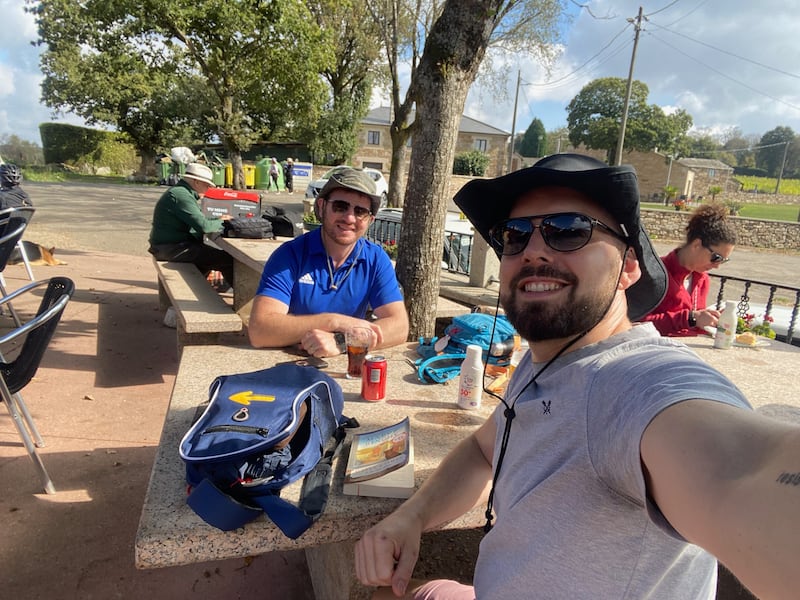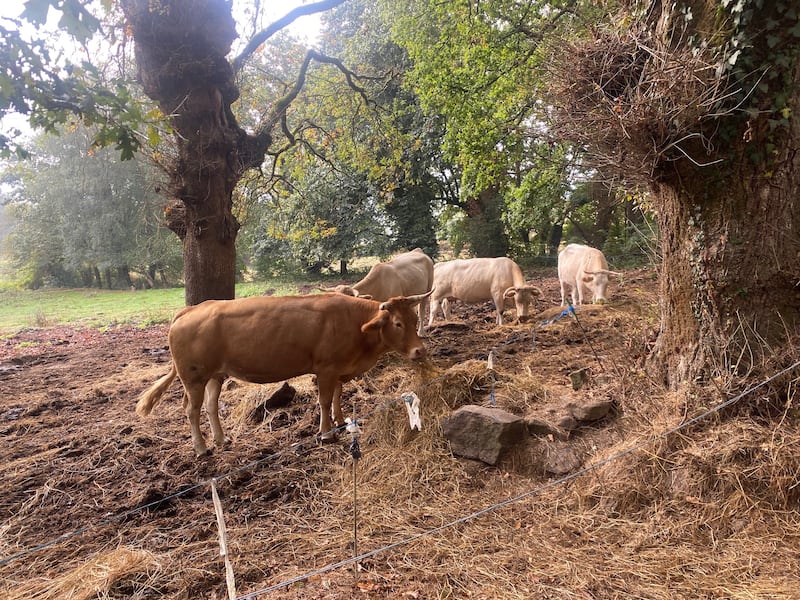Last month, I turned 40. Unlike my other “zero” birthdays, I found I had little interest in marking it with a typical celebration. Forty felt different. I found myself quietly contemplating the fact that somewhere in the next decade (based on average life expectancies) I would likely have fewer years ahead than behind me. That felt serious and, as my birthday approached, I had a heightened awareness of how important it was to use time wisely.
From this mindset, I booked my husband and I to walk the final section of the French Camino, from Sarria to Santiago de Compostela in northern Spain, on my birthday week. I hoped it would allow time for reflection; I’m not religious in the traditional sense, and I find the word “spiritual” offputting. Yet, as a writer, I have spent a lot of my life thinking and reading, taking time to contemplate questions about life’s meaning, attempting to understanding human behaviour, including my own, and wondering is there a wider presence behind it all.
The first day of the pilgrimage, as the sun arose above the trees lining the Rio Sarria, we walked through the town to the overwhelming chorus of birds. John and I selected our stones; part of the Camino ritual is carrying a stone, which one leaves behind at some point on the journey, in a symbolic act of letting go. We bought our scallop shells from a tourist shop, as it seemed everyone on the pilgrimage had one hanging from their bags, and collected our pilgrim passports to get stamped at the various stops along the journey. In many ways, the whole Camino is one large ritual, built on these smaller ones.
[ Paul Flynn: Eating all around us on the CaminoOpens in new window ]
We made our way into oak woodland cloaked in mist. I was reminded of the forests around my childhood home in Cork. Other than the small Romanesque churches dotted along the route, it was Ireland as I knew it in the late 1990s. There were small farms of cows, with old-fashioned milking parlours, rusting farm equipment, as well as yards with pigs and dogs and mules. The first two days passed in this way, the foggy mornings dissolving into blue skies, the dappled light travelling through the unpredictable paths of the branches, vibrant green prickly chestnuts strewn on the paths, the small orchards of fallen apples, hedgerows dense with ferns, and muddy fields with limousin cows, with occasionally the rhythmic sound of crickets. What I grew to enjoy was the messages (graffiti) that had been left by others along the trail: “LOVE is aLL!”, “The journey is the reward!”, “How do you know if someone loves you?”, “Follow your dreams”, and “Sh*t is hard, but you are harder”.
READ MORE
Of those we met on the route, quite a significant number were groups of Spanish students. Occasionally we heard English speakers, mostly American or Irish, but for the most part it was a simple “Buen Camino” as we passed fellow travellers. The few Americans we spoke to reminded me that for a large portion of travellers it was a religious journey; I winced as they spoke confidently about Christ and God in a way an Irish person would be most unlikely to. One couple from Texas were on the Camino before volunteering in a Christian hostel afterwards, where each evening they show films on the life of Jesus. We walked with for quite some time with another lady and her two daughters, all from Washington State, who had completed most of the Camino route (800kms). She was religious, but in a gentle way. She said her faith had “made her a better person” and spoke of the loss of her husband, her reason for undertaking the pilgrimage.
John and I talked sometimes, sometimes were silent. We spoke about the tension I felt when people spoke of Christ and God. I realised, as a gay man, I assume I’ll be judged by them. We also discussed Galician graveyards, where the dead aren’t buried, but stacked in wall vaults, something that seemed odd to me, as I’d like my body to be placed in the ground where it would be reabsorbed by nature.
Day three, the weather changed. We bought cheap plastic ponchos and tried to make the best of it but when we got to the hotel after seven hours of walking in the rain, I was feeling deeply unspiritual. That day, my knees, through significant amounts of discomfort, reminded me I would be 40 in less than two days. I tried to remind myself that the magical rolling hills of oak forest only existed because there was lots of rain. I thought quite a bit about the stone I was carrying, contemplating what I wanted to leave behind, notably my habit of people-pleasing and the burnout it was causing. I also reflected on my relationship with alcohol, as I’d read several books on sober living in the past year that had resonated.
Day four, we set off before dawn to avoid a weather front due that afternoon. We walked in darkness, using the torches on our phones, while overhead the sky progressed from black to navy. The rains of the previous day had the positive effect of renewing the trail; as the day grew brighter, the greens had become more vivid, and I noticed flashes of yellow gorse and a purple flower not unlike an amaryllis. I made a note on my phone that day. “What is a pilgrimage if you are not religious?” I reflected on Philip Larkin’s poem Church Going, in which he muses about what churches will be used for when religion is done away with. He ends with the idea that they’ll be “serious houses” for those with a hunger to “be more serious”, and I thought about how it related to the Camino.


We avoided the rain and were in our hotel by the time the first heavy splatters hit the windows. I was thankful that afternoon to rest some hours on the bed. I checked my Instagram (my rule was to keep my phone on airplane mode while on the walk) and my attention was caught by Sophia Loren, just 50, discussing a conversation she had with Charlie Chaplin, where he’d said to her, “You don’t know how to say no. It’s a terrible failure.” I’ve rewatched the clip many times since.
On the final day of the pilgrimage I woke up to the sound of John shuffling at the dark corner of the room. When he moved away, I saw two lit candles (in the shapes of 4 and 0) around a makeshift “cake” of Lindor sweets and Italian cannoli. As I blew out the candles, I thought back to the graffiti on the Camino: “LOVE is aLL!”. After breakfast, we walked through shimmering eucalyptus forests, that gave way to increasingly suburban landscape towards Santiago de Compostela. In between some cartoonishly heavy showers, John and I spoke about the journey and what it had meant for us. During the 175,000 steps, what was strange how quickly time had passed, the kind of sensation that occurs when you are out of normal life, like the years during the Covid pandemic, or the way it goes around weddings and funerals.
We passed into the old city and made our way down through a stone archway, the sounds of Galician bagpipes playing, that led to the Praza do Obradoiro. The overwhelming baroque facade of the Cathedral of Santiago de Compostela rose at one side, dominating the skyline. In front of the cathedral, our rituals commenced: we took our picture at the end point of the Camino (marked on the ground) and figured out where the pilgrim office was to get our certificate. Neither of us were sure what to do with our Camino stones; other travellers had placed them in piles at various places along the route; however, looking around at the vast perfectly maintained square, here was neither ideal nor correct to throw them away. After some Google-mapping, I suggested an alternative. There was a small tributary in the city, Rio Sarela, a couple of hundred metres away from Praza do Obradoiro. There, on an ancient stone bridge (like something from The Quiet Man) and after a deep breath, I dropped the stone into the water and said to myself, “I let go of what does not serve me”, bringing my Camino to an end.
[ Jamie O'Connell: How the cost of your expensive cup of coffee breaks downOpens in new window ]
We have a collective myth around the Camino, one that has evolved many rituals over time, which began with an apocryphal story about St James the Great, and from then the devout have flocked along the routes to Santiago de Compostella for more than a millennium. The pilgrims are different now. I, like many, question if the body and bones in the crypt are of St James and I question their miraculous powers. Yet, the one thing that is unchanged for everyone walking the route is they are all seekers of one sort or another. However, I doubt what is sought can be found physically en route. For me, the Camino offers space, a time and place for those who hunger “to be serious”, to discover meaning where it ultimately resides, within ourselves.
Jamie O’Connell is the author of Diving for Pearls




















